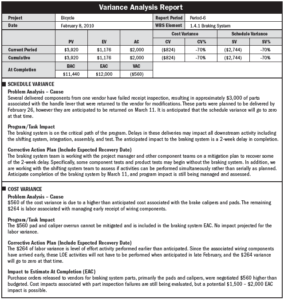
Earned value reporting provides a clear snapshot of project performance, making it simple to communicate progress to senior management and stakeholders. While recipients may need a brief introduction to interpret the metrics, the process is straightforward.
In this blog post, we’ll categorize and explore effective reporting methods tailored to three project scales:
- Small projects
- Medium-size projects
- Large projects
Small Projects
For small projects that last about 3 weeks or less, a simple earned value table that includes the cost and schedule variances could meet the reporting requirements. For example:
| Project Status Report | |
|---|---|
| Date | March 3 |
| Project Budget | $10,000 |
| Schedule Variance | -$1,000 |
| Cost Variance | -$2,500 |
| Comments | A one time purchase of materials has created the negative variances |
It takes about 10 minutes to gather the data, crunch the numbers, and write out a quick status report. This could be done daily to weekly and provides management with an excellent indicator of the project’s status.
Another helpful chart for small projects involves the graphing of the cost and schedule variance over time (period by period). At each status point the data table is given one more column, and the results are graphed to show the trends in the variances over time. The data table looks like this:
| Period | Inputs | Schedule | Cost | ||||
|---|---|---|---|---|---|---|---|
| PV | EV | AC | SV | SPI | CV | CPI | |
| 1 | $1,000 | $1,000 | $1,000 | $0 | 1.0 | $0 | 1.0 |
| 2 | $2,000 | $1,500 | $3,000 | -$500 | 0.90 | -$1,500 | 0.85 |
| 3 | $3,000 | $2,000 | $4,500 | -$1,000 | 0.67 | -$2,500 | 0.44 |
| 4 | $4,000 | ||||||
This is an excellent way to see the bigger picture and get a grasp of project performance issues that the one time snapshot doesn’t give you. For example, if the SPI had gone down very quickly but was now trending upward, maybe this is less concerning than an SPI that isn’t as bad right now but is trending downward.
On this chart a positive situation would be where the EV is above the PV and the AC is below. Thus, in this example they are both trending negative.
Medium Sized Projects
For projects that last between about 3 weeks to 6 months, a status report that looks closer to “full size” might be more useful. It indicates efficiency levels and projected completion dates and budgets. People who are familiar with all of the earned value metrics can follow the ones they are most comfortable with.
| ID | Name | Start | End | BAC | PV | EV | AC | SV | SPI | CV | CPI | ETC | EAC | VAC | TCPI |
|---|---|---|---|---|---|---|---|---|---|---|---|---|---|---|---|
| 100 | Set up Database | Mar. 1 | Mar. 10 | $10,000 | |||||||||||
| 110 | Acquire Server | Mar. 1 | Mar. 2 | $1,500 | |||||||||||
| 120 | Set up Data Structure | Mar. 3 | Mar. 3 | $1,000 | |||||||||||
| 130 | Move Data | Mar. 4 | Mar. 10 | $7,500 | |||||||||||
| 200 | Build Application | Mar. 7 | Mar. 20 | $15,000 | |||||||||||
| TOTAL | $35,000 | ||||||||||||||
In this example the 100-level tasks are summary tasks (phases) and the 110-level tasks are sub-tasks. That’s how I’m used to doing it but any work breakdown structure is acceptable. You could also report the metrics by phase, at the 100-level only.
The period by period view is slightly more involved. A spreadsheet might be necessary because of the many periods that will be involved. The data table might look similar to this:
| Period 1 | Period 2 | Period 3 | Period 4 | Period 5 | |
|---|---|---|---|---|---|
| BAC | |||||
| PV | |||||
| EV | |||||
| AC | |||||
| SV | |||||
| SPI | |||||
| CV | |||||
| CPI | |||||
| ETC | |||||
| VAC | |||||
| TCPI | |||||
| EAC |
Senior management generally favor the forecast values (ETC, EAC, VAC, and TCPI) whereas stakeholders favor the current project status (SV, SPI, CV, and CPI). But any one of the variables can be charted to see the trend over time, in fact the trend is more important than the current value for many of the variables.
Large Projects
On large projects which last more than about 6 months you would normally have a “full size” earned value report as there are likely to be stakeholders who are comfortable with the method and understand the numbers. Each metric is communicating a specific thing, and thus stakeholders should be informed as best as possible. Projects of this size usually have a full time project manager (or at least mostly full time) therefore they usually have time to do this analysis.
In addition to the project status report which contains the above earned value metrics, a task status report could be filled out which contains the following information:
- The earned value metrics for the task: BAC, PV, EV, AC, SV, SPI, CV, CPI, ETC, VAC, TCPI, and EAC.
- The current status of the task.
- Work that has been completed to date
- Schedule for work during the next status period
- Cost Variance
- Cause of variance
- Impact on project budget
- Corrective action plan, if applicable
- Schedule Variance
- Cause of variance
- Impact on project budget
- Corrective action plan, if applicable
As with the medium size projects, a “trend over time” chart can also be created for the earned value metrics the project manager deems valuable, as well as any other metrics the stakeholders request.
When variances require explanation, a form like this Variance Analysis Report can be used to communicate why variances are beyond a certain threshold, for example CV or SV is greater than 20% of BAC. This form has been taken from the PMI Practice Standard for Earned Value Management, 2nd Edition:
There are a myriad of ways the project’s progress, status, and forecast can be reported. That’s why for large projects we recommend the project management team be familiar with the reporting options outlined within the Practice Standard for Earned Value Management, by the Project Management Institute. A strategy needs to be determined based on the needs of management and other project stakeholders. Project specific forms can be developed, if necessary. The project management plan, in the stakeholder communication section, should contain the details of how and when the reporting will take place.
Good luck on your projects! For further reading check out the Earned Value Management System. If you need a good top to bottom primer on Earned Value, be sure to check out our Earned Value Tutorial.














Leave a Reply